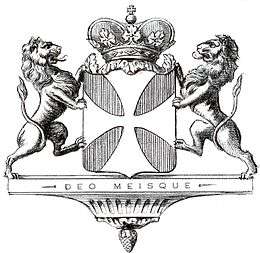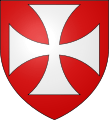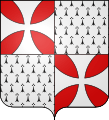House of Rougé

The House of Rougé is a family of the French nobility, documented since the 11th century, originally coming from the locality of Rougé in Brittany. Their line descends from Rivallo IV of Brittany, himself the son of Saint Salomon, King of Brittany. Through marriages, as well as the valour of their members, the Rougé became one of the most important feudal houses in Brittany between the 13th and 15th centuries, as well as key players in the relations between the Duchy of Brittany and the neighbouring kingdoms of England and France.
Since 1220, the lords of Rougé had developed strong ties in the western province of Anjou, where they flourished, and became prominent after the loss of most of their Briton territories (first half of the 15th century). They then held important military positions in the armies of the King of France.
People
Among the more illustrious members of the House of Rougé were two knights crusaders (1st and 7th Crusades), three ambassadors for the King of France (to England, Modena and Rome), a bishop of Périgueux, two Abbots of Bonrepos Abbey, a knight involved in the Spanish Reconquista, a governor of Le Mans during the Wars of Religion, several French generals, two hereditary peers of France, a princess of the Holy Roman Empire, a professor at the Collège de France, a famous Egyptologist, who succeeded to Champollion, several senators and members of parliament of the French Republic, two of the first French military pilots, and soldiers killed in action.
The Rougés founded the Abbey of Meilleraye de Bretagne in the 12th century. The Maine-Anjou (cattle) was created by a Rougé at the beginning of the 20th century.
The family also hold the duchy of Caylus, with Grandee of Spain, and was made marquis, count and viscount de Rougé, du Plessis-Bellière and du Faÿ (Faÿ-lès-Nemours), peer of France, Lord of Derval, Baron of Coëtmen.
In Brittany
Mentioned for the first time in 1045, the lords of Rougé descend from Rivallo IV of Brittany, Count of Poher, himself a member of the sovereign house of Brittany.
However, they had strong ties to the neighbouring house of Derval, and of Chateaubriand, with whom they intermingled. In 1275, Olivier IV de Rougé married the heiress of the Lordship of Derval, and so became himself Lord of Derval and a prominent force in this region of Brittany, holding the fiefs of Rougé and Derval, as well as other less important ones. The duke was developing stronger ties with the nobility around Nantes than with the northern or western lordships of his duchy, constantly looking for rebellion.
The most illustrious person of this line was certainly Bonabes IV de Rougé de Derval, who played a key role in the Briton war of succession between Jean de Montfort and Charles the Lame of Blois, being a counsellor to the King Jean of France after the defeat of Charles de Blois. Bonabes IV was imprisoned in the Tower of London, from which he escaped, with the brother of the king.
In Anjou
The first known Rougé in Anjou is Aymeri of Rougé, mentioned as the Lord of Les Rues, in 1220. It is now in the town of Chenillé-Changé.
This line includes Jacques de Rougé du Plessis-Bellière, the Marquise du Plessis-Bellière, his wife; Pierre-François, Marquis de Rougé; Bonabes, Marquis de Rougé; and later Bonabes de Rougé, among others.
In Picardy and Champagne
After the death in action of Pierre-François, Marquis de Rougé, and the death of his wife Julie de Coëtmen soon after, H.S.H. the Princess Innocente-Catherine de Rougé du Plessis-Bellière, Duchess of Elbeuf and Princess of the Holy Roman Empire, adopted the orphaned children of her cousin the Marquis de Rougé. This extremely wealthy lady gave them in due course the lordships of Moreuil, Villers-aux-Erables, Vienne-le-Château, and significant estates in Picardy and Champagne.
List of lordships held by the House of Rougé
Rougé, Derval, Soulvache, Sion-les-Mines, Moisdon-la-Rivière, Soudan, Grand-Fougeray, Les Rues, Le Plessis-Bellière, Chenillé-Changé, La Guerche (Anjou), Moreuil, Villers-aux-Érables, Guyencourt, Faÿ-lès-Nemours, Courtimont, Le Plessis-Courtimont, Roisson, Les Touches, Le Theil, Le Teilleul, La Mauvesière, Le Bignon, Sainte Scolace, Vauregnoust, Lorière, Marigné, Le Plessis-Gaudin, La Bellière, Le Bois, La Cour-du-Bois, Maigné, Chigné, Les Mortiers, Dissé, La Courtaillé, La Gauberdière, Les Feuges, Launay, Le Bouays, La Chapelle-Glain, Neuville, La Roche d'Iré, Cinq-Mars-la-Pile, Rouaibile, La Cornouaille, Pontcallec, Gastines, Valençon, Saint-Pierre, La Frébaudière, Langeron, Le May, Montfaucon, Vienne-le-Château, Cholet, Chemillé, Le Tremblay, La Cour de La Raye, Rostrenen, Kerjean, etc.
-

Bonabes II, sire de Rougé,
-

Jean II, sire de Rougé-Derval, en 1332,
-

House of Rougé
Famous alliances
de Lorraine Elbeuf, de Craon, de Croÿ, de Crussol d'Uzès, de Rochechouart de Mortemart, de Choiseul-Praslin, de La Croix de Castries, de Beaumanoir, de Châteaubriand, de Colbert, de La Rochefoucauld, de Clermont-Tonnerre, de Walsh-Serrant, de Lignerac de Caylus, de Rohan-Chabot, de Saint-Georges de Vérac, de Sainte-Maure Montausier, de Blanchefort de Créquy, de Pastoret, d'Albert d'Ailly, de Cardevac d'Havrincourt, de Bertoult d'Hauteclocque, de Maillé, de Coëtmen, de Léon, de Rieux, de Châteaugiron, de L'Isle-Bouchard, de Goulaine, de La Tour Landry, de Derval, de Neuville, de Gastines, de Tournemine de La Hunaudaye, de Coëtquen, de Penhoët, de Sesmaisons, du Pouget de Nadaillac, de Francqueville, de Malet de La Garde, de La Tour du Pin Chambly de La Charce, de Mandat-Grancey, de Nettancourt-Vaubécourt, de Cornouaille, d'Andigné, de Maigret, de Pomereu d'Aligre, de Pierre de Bernis Calvière, de Quatrebarbes, de Tramecourt, de Forbin d'Oppède, de Beauffort, de Boisgelin, de La Ville de Baugé, de Cassagnes de Beaufort de Miramon-Pesteils de Miramon-Fargues, de Blocquel de Croix de Wismes, de La Panouse, de Ganay, de Sonis, de Cossé-Brissac, de Maupeou d'Ableiges, d'Oilliamson, Colonna-Walewski, de Croÿ d'Havré, de Bruc de Montplaisir, de Kerhoant de Coëtanfao, de Keroüartz.
Castles
The House of Rougé held the following castles :

- La Motte-Glain, La Chapelle-Glain
- Derval,
- Les Rues, in Chenillé-Changé
- Le Haut-Rocher, in Chenillé-Changé
- Bois-Dauphin, in Précigné
- Sablé-sur-Sarthe,
- Moreuil,
- Grand-Fougeray,
- Guyencourt-sur-Noye,
- Villers-aux-Erables,
- Coetmen, in Tréméven
- Tonquédec,
 Château de Tonquédec
Château de Tonquédec - Chateau de Baronville, in Béville-le-Comte
- Dinteville,
- Mesnil-Voysin,
- Bonaban,
- La Bellière,
- Le Charmel,
- La Guerche, Château de la Guerche
- Roche d'Iré,
- Courtimont,
- Faÿ-lès-Nemours,
- Pontcallec,
- Tremblay-sur-Mauldre,
- Rostrenen,
- Kerjean,
- Saint-Symphorien,
 Château de Tressé
Château de Tressé - Pouancé, château de Tressé
- Les Essarts, Vendée
- Les Bouysses
Titles
- Lord of Rougé (since 1045)
- Lord of Rues and Chenillé (since 1220)
- Lord of Derval (since 1275)
- Viscount of La Guerche (since 1365)
- Marquess and Count of Plessis-Bellière and of Faÿ-lès-Nemours (since 1651)
- Baron of Coëtmen (since 1749)
- Marquess and Count of Rougé (since 1701, confirmed 1815 and 1827)
- Marquess of Cholet, Baron of Montfaucon and of May (since 1760)
- Peer of France (since 1815)
- Duke of Caylus with Grandee of Spain (since 1893)
.jpg)
Sources
- Lobineau, Dom, Mémoire pour servir de preuves à l'Histoire de Bretagne
- Courcelles, Chevalier de, Histoire généalogique de la Maison de Rougé, Béthune, 1830.
- Borel d'Hauterive, André, Notice historique et généalogique sur la Maison de Rougé, Annuaire de la Noblesse de France, 1880.
- Rougé, Vicomte Olivier de, Histoire Généalogique de la Maison de Rougé, Chartier Vendôme, 1908.
- Wismes, Armel de, Ainsi vivaient les Français, Jean-Pierre Gyss éditeur, 2001.
- Rougé, Comte Bertrand de, Le Château de Tonquédec, Editions Ouest-France, 2000.
- Morand, Paul, Fouquet ou le Soleil Offusqué.
- Bazin, Raymond, La Fronde en Normandie, Dieppe, 1907.
- Almanach de Gotha
- Bottin Mondain
- La Barre de Raillicourt, Dominique de, Les Titres authentiques de la noblesse en France, Editions Perrin, 2004.
- Quid.
